#integration
Text
if I see people mix up fusion and integration one more time…
INTEGRATION IS WHEN YOU LOWER AMNESIC AND COMMUNICATION BARRIERS BETWEEN ALTERS THIS IS A GOOD THING AND YOU SHOULD BE WORKING TOWARDS THIS NO MATTER YOUR RECOVERY GOAL
FUSION IS WHEN 2+ PARTS BECOME ONE PART
THESE WORDS ARE NOT INTERCHANGEABLE THEY MEAN COMPLETELY DIFFERENT THINGS
#made by icarus#please use these words right so I don’t have to fucking guess what your post is about#did system#osddid#actually did#traumagenic system#integration#fusion
742 notes
·
View notes
Text
Toto learning how the snuffle mat works and being a very good boy giving newt space when newt comes closer to his forager to reduce conflict around the resources
418 notes
·
View notes
Text
So like, breaking down dissociative barriers. Increasing communication. All good things, right? But how do you even do that?
Turns our "breaking down barriers" is completely the wrong way to go about that. I've been trying to take a metaphorical hammer to these fucking walls and instead of them coming down they just keep reinforcing themselves.
But, surprise! It's not a fucking wall and that's why hammering away has done jack fucking shit all. No, it's an ocean wave, and I'm supposed to just sit still and let the tide wash over me and engulf me from head to toe.
God, we really need to rethink how we talk about our experiences and stuff with each other. No wonder some people struggle so hard with understanding how to actually work together with the other alters in their system, or integrating aspects of themselves with each other. Most people tend to use the same few phrases that get passed around the community, which helps ease communication when we all know the basics of what we're talking about, but god does it really stifle the discussions we can have sharing what those experiences are actually like on an individual level.
Anyways I'm gonna stop thinking of working on internal communication and integration as "breaking down dissociative barriers" and instead think of it more as "letting a wave of internal experiences engulf me".
#dissociative identity disorder#did#actually did#actuallydid#did osdd#osddid#cdd#integration#dissociation#by ???#I'm part of Green's subsystem but I'm not the usual Green#guess I'll still use his tag#by green
115 notes
·
View notes
Text
Final Fusion Misinformation
You might have seen people saying something like this before: "studies find that final fusion only works 12.8% of the time." When I was pursuing final fusion, people in the community threw this 12.8% at me to try and discourage me from my desired recovery. After all, what's the point of pooling all of my time & energy into pursuing final fusion if it has such a low success rate?
Although I don't know where exactly this "low success rate" idea came from, most people I know explain that The Plural Association introduced it to them. This would make sense, because this nonprofit frequently states that final fusion has a 12.8% success rate on their webpage & resources. Here's some examples:

(Source)

(Source)

(Source)
Now, here's the thing:
This is at best a misquote & at worst purposeful misinformation.
The study that is linked here does not say that final fusion is only successful 12.8% of the time, or that only 12.8% of DID patients achieve final fusion.
In this study, a handful of DID clinicians are interviewed about their patients. It says that 39 patients terminated their therapy. 25.6% of those patients said that they reached a successful resolution in their therapy, they no longer needed it. 12.8% of those no longer needed therapy after full fusion, 12.8% no longer needed therapy but didn't fully fuse.
This is not a success rate. This does not say how many patients achieved final fusion. This is just a reason behind why some people left their therapy. The percentage is the same for people who did and did not achieve final fusion.
Here's the exact quote from the study:

(Source)
I have no idea how anyone can take a look at this and misconstrue the 12.8% to be about how successful final fusion is. It's possible it was just a misunderstanding, but I have trouble trusting that as The Plural Association has cited this study multiple times, including writing a whole article on it, yet continues to misconstrue final fusion as only being successful in 12.8% patients when that's just, blatantly, wrong.
Please reblog & spread this! Final fusion is horrifically stigmatized and fully fused systems are subjected to frequent harassment & misinformation about their recovery choices. It's not okay, and we should hold nonprofits like The Plural Association to better standards.
#actuallydid#actuallydissociative#actuallytraumagenic#actuallyplural#final fusion#integration#DID recovery#misinformation#anti fusion#anti recovery#look out#community issues#the plural association
220 notes
·
View notes
Text
"Integration is healthy and disintegration is unhealthy" is an overly simplistic, spiritual bypassing view to throw in the bin. I'm going to invite you to view it in a different way.
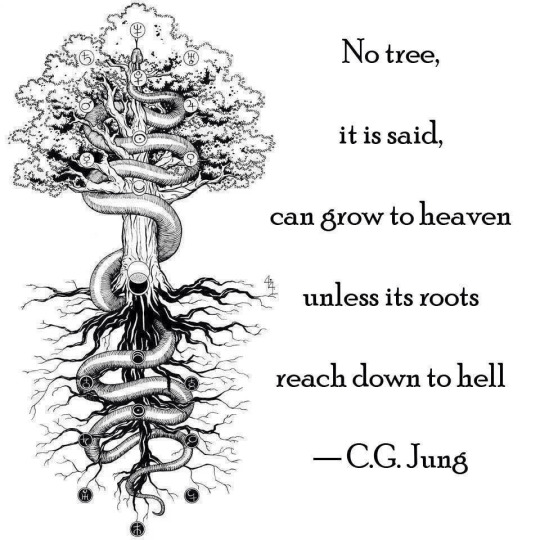

Integration is your heaven. Your light. It represents what you aspire to embody, but feel scared to embody, or cannot seem to embody no matter how hard you try. You do not have enough personal development, insight or healing to embody your integration type properly. False security is when you embody your integration type in a shallow way. You indulge in your integration type without having done enough healing to make the transformation secure, deep-rooted and long-term. You're reaching up to heaven but your roots don't reach down to hell, and so your extension is very short-lived. The excess branches you have grown to reach up to your integration type quickly die or worse, get infected, as your root system down in hell is not strong enough to sustain the tree. After periods of false security you are left with a lot of trauma, a big mess in your life, and you get pulled right back into your disintegration type's grip. You indeed can integrate in an unhealthy way... and you can also disintegrate in a healthy way. Keep reading.
Disintegration is your hell. It represents your natural stress response, your toxic coping mechanism, the thing you just really hate in yourself and in other people, your default way of overcompensating for your core type's missing pieces, your darkness. Inside your disintegration type is a wealth of secrets and wisdom that you need to uncover, including your wounded inner child. When we analyze our disintegration type and our own personal disintegration experiences, we learn a lot about ourselves. We can only learn what we are missing and what we need to work on from our disintegration type, not from our integration type. Healthy disintegration provides us the necessary foundation that we need in order to reach up towards our integration type. Disintegration is not something to be resisted the same way that cleaning your room and doing exercise is not something to be resisted just because it doesn't feel good. Conscious Disintegration is an essential part of shadow work. It is what Carl Jung would call "making the unconscious conscious".
-----
Integration and disintegration are definitely not the same. But they are also not black and white, "one is good and the other is bad". If you view it this way you are bound to bypass your necessary shadow work and end up in a cycle of false security and extreme disintegration.
#enneagram#enneagram 1#enneagram 2#enneagram 3#enneagram 4#enneagram 5#enneagram 6#enneagram 7#enneagram 8#enneagram 9#shadow work#carl jung#personality theory#typology#integration#disintegration
161 notes
·
View notes
Text
Alternative System Mind Mapping Method for Communication
[DISCLAIMER: This is not a professional or scientifically or anything really backed method, this is something coming solely from peer / personal experience.]
In regards to an anon ask earlier, I was thinking about it and one of the ways we've approached improving communication - particularly internal - in a way that is a lot less prone to flooding or dealing with trauma or anything too overwhelming - is by approaching it following the concept of Memory Webs
I haven't read up on them recently, but "Memory Webs" were a thing that our AP Psychology teacher in highschool made us do because the AP Psych test was term / jargon heavy. Memory in the human brain has been shown to be HEAVILY associative and the ability to remember and connect things tends to rely on following a "web" of connected topics, ideas, concepts etc from one idea to the next.
So in our AP Psych class, she gave us these GIANT books for Vocabulary Webs that we had to slowly work on, each of which required 6 other vocab words / related concepts, a summarized definition, and an image to represent it. By doing this, you added 6 cues to recall the word (increasing the chance you'd remember it), a visual cue, an episodic memory of working on it, and a definition - all in all improving how connected the word is to other concepts in your brain and making it easier to recall it.
I personally like to look at DID and our parts in a similar manner sometimes where the large issue is that a lot of the nodes in the web of associations are either disconnected or connected through a hard-to-find and/or small chain. In that sense, parts struggle to be held together because they are not associated concepts. It's hard to reach other parts because the dissociative walls (which in our unsubstantiated opinion is less a 'wall' and more so a lack of reinforced neural connections, so I would call them dissociative caverns) keep associations from forming
As a result, alternative to more traditional ways of mapping your system and parts, a method I've liked to internally visualize systems and navigating system dynamics is through a memory web manner. (I actually have never done it physically cause the Ray part of my brain - also the most prominent part writing this rn - rarely liked to front if he didn't have to and did a lot of stuff internally)
Here's a bit of a breakdown using six of our parts if any of you want to try it out.
We personally like it because it strips a lot of trauma and stress off of it and makes it a lot more of a positive and present engaging activity.
For the purposes of this, I'll be using the free online app of Milanote cause we've used it before for OC associative webs and I think it'll do fine enough.
(Honestly it actually might just be a good way to log alter information now that I'm looking at it if you are at a place in recovery where keeping track of that physically helpful)
So we can start by dropping down the parts we want to include in the form of boards

So from here, we have a bunch of disconnected parts. However, we find that a lot of these parts have things that mean a lot to them, that illicit a strong emotion or reaction from them.
Some parts may lack it more than others (often in our case trauma holders and/or trauma locked parts) and that's okay and to be expected. This is a visualization method and if there isn't much connecting a part that is 100% okay.
For demonstration sake, I will now add bubbles around each part of things that were pretty early apparent that each individual liked.
Also for the purposes of how I know our system works and how I plan to do this, I am actually moving Riku to the center and you will all see why Riku is such an S tier center point with this model
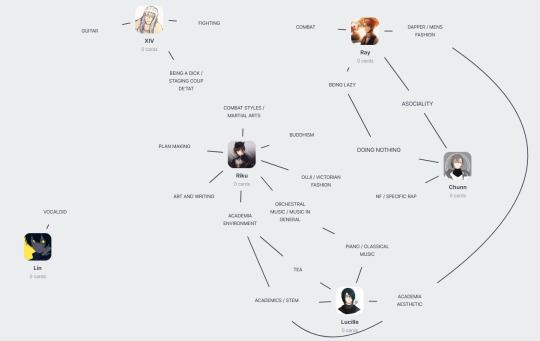
So you can see some connections forming.
Some key things you can take from this visual that also applied to earlier stags of how we connected
Lucille and Riku are and have always been pretty darn connected, they go back as one of the longest duos and were split almost as a pair to deal with academics
Chunn and Ray have a very shared interest of "I don't want to do anything leave me alone"
XIV literally was just a piece of shit early on and didn't have any immediate HARD connections with anyone largely because he never was interested in actually engaging in things he liked in a positive way as his "favorite emotion" at the time was "being pissed off"
Lin - an originally trauma stuck / loop - is very very poorly associated with anything that isn't overtly trauma related (and that is saying something cause Vocaloid is trauma related) and thus has very few connections to other parts
So looking at this though, there are a few things that have some similarities between parts. What you can do is make plans to try to foster the interests that you do have and try to generalize it a bit more to also encompass what interests other parts have. So lets engage in hobbies a little more - explore a few concepts that mean a lot to parts independently - and find some more generalized version of those hobbies
(forgot to add easy listening to Ray's and "only wearing monochrome*" to XIV's earlier)
(*there are a lot of nuances and caveats)
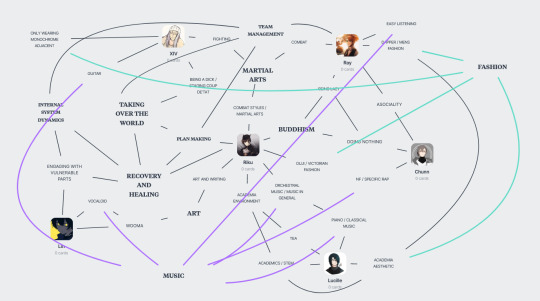
Damn, look at that. It's messy and ugly to have in a 2D form. I absolutely hate it, this would be so impossible with our whole system. But HEY, it's very connected - and that's the goal.
Compared to the previous one, you can see how easily it can be for one part's interests to start to drift into another. Because they are largely and strongly associated features to each part, they are a lot more accessible when engaging in their shared / associated connections and interests which makes it easier for the them to stay together near the front, stay associated with one another, and work with and communicate with one another.
Of course anyone following this blog goes "Where tf is Birds" and that I left out because it would ruin the point of the web as it actually is one of our traditional "you are around the system a lot? okay pick a bird" which serves to 1) be a fun system culture thing 2) be a means of welcoming a part in and 3) helps establish a foundational connection; we do the same with music but with music its a lot more elaborate and I probably wont explain it for other reasons.
But overtime, by fostering interests that were already present and encouraging parts to broaden and generalize their specific interest a bit, you end up with a lot of overlapping associations that can greatly improve internal communication, co-fronting ability, and just general fluidity and easy of moving around the brain web.
It becomes a good way of trying to figure out what you can do to encourage and help build connections and associations between parts by seeing where things are similar / could have more overlap (combat and martial arts, different types of fashion, different types of music, different appreciation for arts, taking over the world, yada yada yada)
And you wanna know the coolest thing? When you step back from the whole web you can see certain things appear that stand out the most and have some of the most connections.
If you ever intend to go to Final Fusion, those are the things that will likely be the most prominent traits of your whole self
For us? [REDACTED BIRDS for the point of the demonstration], Music, Fashion, Taking over the World, Recovery and Healing, Buddhism, Martial Arts, Arts in general - they're all some of our largest traits that persist in almost all forms as individual parts, partially fused parts, and fully fused parts.
And the BEST part? Doing this didn't require us to touch trauma at all.
Of course in recovery that will come up cause PTSD doesn't ask permission, but its a very low stress way to help improve internal communication and engagement with one another.
#actuallydid#dissociative identity disorder#resources#advice#internal communication#integration#feather's unsubstantiated theraputic tools#unsubstantiated advice#alter: fei#final fusion#functional multiplicity#wishiwashi recovery#system mapping#system map#mind mapping#mindmap#recovery#healing#alter: ray#<- heavily authored by that part of this brain#system dynamics
142 notes
·
View notes
Text
Wholeness is not achieved by cutting off a portion of one's being, but by integration of the contraries.
Carl G. Jung
#carl g. jung#carl jung#jung#quotes#philosophy#wisdom#life#literature#writer#books#psychology#write#art#artist#idea#ideas#psychoanalysis#wholeness#integration#archetype
117 notes
·
View notes
Text
hey. integration is not fusion. although integration is necessary for fusion, fusion is not the same thing as integration. it's like how all thumbs are fingers, but not all fingers are thumbs.
integration is key to functional multiplicity. and integration is not fusion.
82 notes
·
View notes
Text
Our therapist wants us to integrate (merge alters) but I don't want to...I don't wanna lose them, they're my friends...
#actually plural#plurality#plural#plural system#plural community#plural culture is#pluralgang#did system#median system#system#system stuff#system things#osdd system#traumagenic system#systemblr#system blog#integration
49 notes
·
View notes
Text

Throwback Thursday!
Thank you so much for supporting my work!
Patreon.com/kimchicuddles
[Image Description:
Panel 1:
"Sometimes I struggle with thinking I should feel a different way."(image of shouting at feelings monster: "Get lost, sadness!". Feelings monster in chest: "NO!!")
Panel 2:
"But beating myself up about it doesn't feel better either..."
(image of person shouting "I said get lost!!". Feelings monster: "NOOOO!!!")
Panel 3:
"until I start being gentle with the part of me that's struggling with being gentle"
(image of same person holding tiny version of themselves inside their chest, that is also holding feelings monster. Person says "you mad about being sad? That's OK". Tiny self says "Rawr". Feelings monster looks more calm, says "rawr").]
48 notes
·
View notes
Text
This video has it all:
Gay Love
Coming on TOO STRONG
Foot fetish
Synchronized Scratches
Attempting to shove your husband off a cliff
#Toto was on to something with that foot presentation#newt was just pretending not to like it to avoid judgement#newt#toto#preening#allopreening#cuddles#integration#introductions#behaviour#regurgitation
273 notes
·
View notes
Text
Is Natural Science finally committed to materialism? There is no doubt that the theories of science constitute trustworthy knowledge, because they are verifiable and enable us to predict and control the events of Nature. But we must not forget that what is called science is not a single systematic view of Reality. It is a mass of sectional views of Reality - fragments of a total experience which do not seem to fit together. Natural Science deals with matter, with life, and with mind; but the moment you ask the question how matter, life, and mind are mutually related, you begin to see the sectional character of the various sciences that deal with them and the inability of these sciences, taken singly, to furnish a complete answer to your question. In fact, the various natural sciences are like so many vultures falling on the dead body of Nature, and each running away with a piece of its flesh. Nature as the subject of science is a highly artificial affair, and this artificiality is the result of that selective process to which science must subject her in the interests of precision. The moment you put the subject of science in the total of human experience it begins to disclose a different character.
Muhammad Iqbal, The Reconstruction of Religious Thought in Islam
#quote#Muhammad Iqbal#Iqbal#Allama Iqbal#science#nature#reality#scientism#Islam#Islamic philosophy#religion#natural sciences#natural science#theology#holism#integration#materialism#philosophy
44 notes
·
View notes
Text
This post is about final fusion & integration. Don't read it if that's triggering to you (duh).
I'm someone with DID who has achieved final fusion. What that means is that my entire system came together to always be present, aware, and connected. We no longer experience the dissociation that made us into separated alters and became interconnected. It's like making a connection of lines between stars; a constellation. No one in my system disappeared or died...although some people like to spread myths like that.
It hurts when people say that my system achieving final fusion is like suicide when it's obviously not. What hurts more, however, is when people say that final fusion doesn't work. "You might split again," they say. "Most people fall apart after they achieve final fusion. It isn't worth it."
Telling someone that their choice in recovery is never worth it because "they might relapse someday" is never okay. Why do people condone it when it comes to fusion? What happened to statements like "recovery isn't linear?" What happened to that?
It's normal to fall apart after final fusion because it takes time to get used to an existence that's not split up and dissociated. Final fusion is a process not a one-and-done kind of deal. You have a mind that is primed for dissociation, which has always relied on dissociation in the past, and for the first time ever you are telling it no! It's okay for all parts of you to be present and aware!
That takes time and practice. No one should be shamed for falling apart after fusion. It's still possible to achieve final fusion again after falling apart and most of us consider this part of the process. This goes for any form of recovery. To quote Rachel Dowing, "I had many experiences of integration followed by disintegration. With the help of my therapist, I learned to view this as a natural process, not a series of failures. I needed practice at being integrated and learning to use new defenses."
If you want it, final fusion is worth it. If you don't want it, it's worth it for the people who do. Support them.
#actuallydid#actuallydissociative#actuallytraumagenic#actuallyintegrated#integration#final fusion#fusion#suicide tw
367 notes
·
View notes
Text
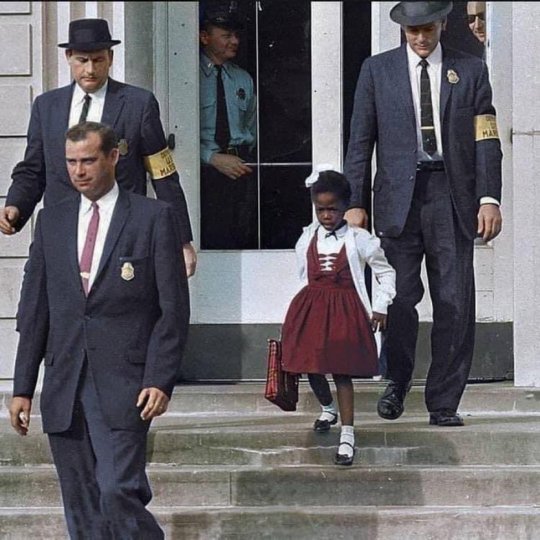
Happy Birthday Ruby Bridges. We THANK YOU!!❤️❤️❤️
Ruby Bridges was born in Tylertown, Mississippi on September 8, 1954.
69 notes
·
View notes
Text
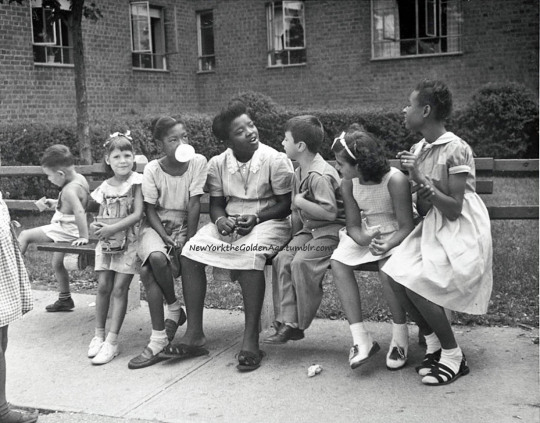
"Meeting of the Minds," Kingsboro Housing Project, Ocean Hill, Brooklyn, 1940s.
Photo: Joe Schwartz via the Smithsonian National Museum of African-American History & Culture
#vintage New York#1940s#Joe Schwartz#children#Kingsboro Housing Project#public housing#integration#vintage Brooklyn#vintage NYC
139 notes
·
View notes